Management and Operations: A Detailed Study of Marks and Spencer
VerifiedAdded on 2022/11/24
|11
|4164
|245
Report
AI Summary
This report provides a comprehensive analysis of the management and operations at Marks and Spencer, a UK-based multinational retail corporation. The report begins by examining the organization's flat management structure, highlighting its benefits such as ease of operation, reduced middle management, increased productivity, and improved communication. It then differentiates between the roles of managers and leaders, detailing their respective responsibilities and functions. The report explores various leadership and management theories, including situational, systems, and contingency leadership, evaluating their strengths and weaknesses. Furthermore, it assesses the impact of managers and leaders on organizational goals, employee motivation, and production capabilities. Part B delves into the key operations at Marks and Spencer, including operational functions, theories, and the influence of external factors on decision-making. The report concludes by explaining various leadership and management approaches employed to meet business objectives, providing a holistic overview of Marks and Spencer's management and operational strategies.
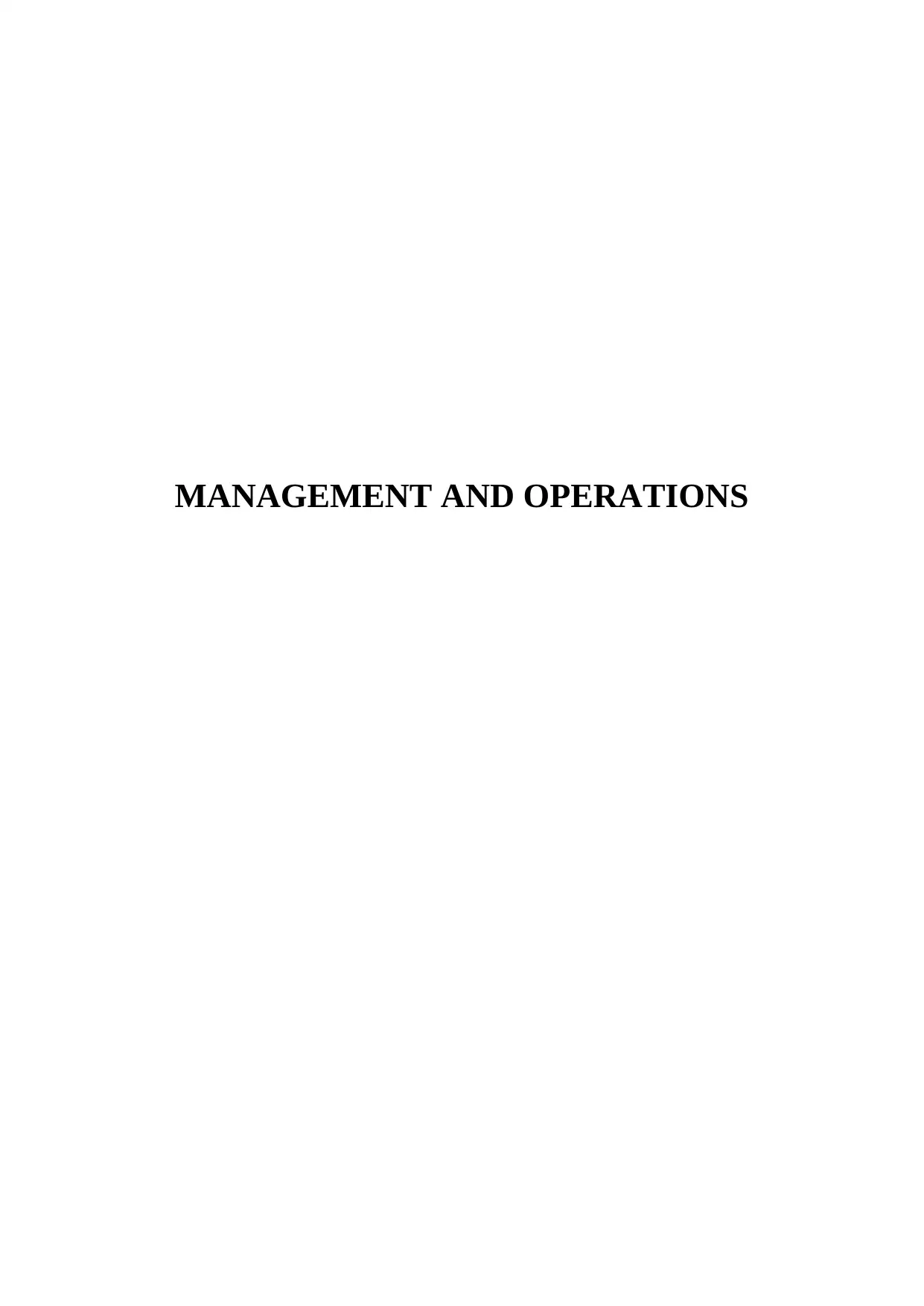
MANAGEMENT AND OPERATIONS
Secure Best Marks with AI Grader
Need help grading? Try our AI Grader for instant feedback on your assignments.
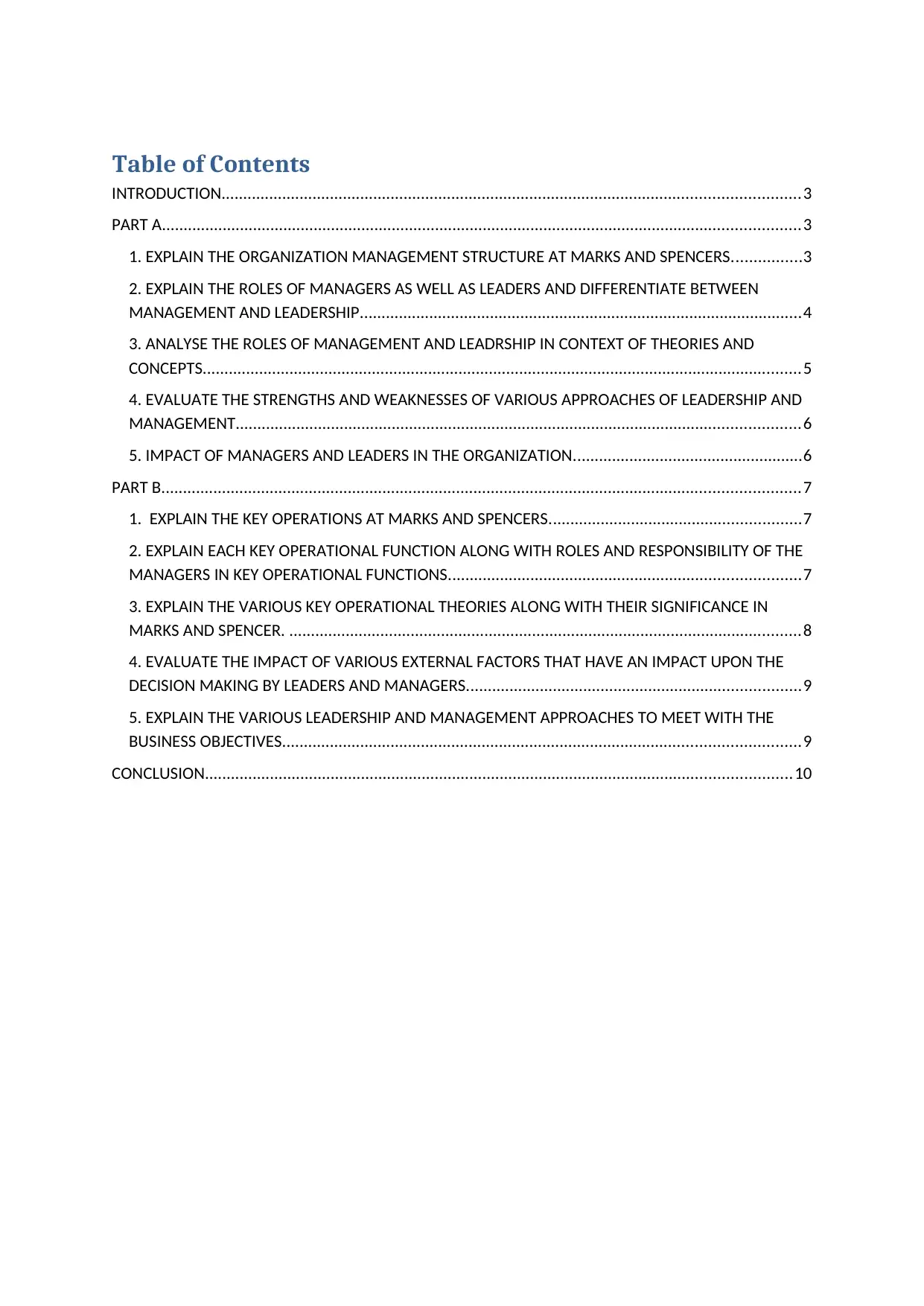
Table of Contents
INTRODUCTION.....................................................................................................................................3
PART A...................................................................................................................................................3
1. EXPLAIN THE ORGANIZATION MANAGEMENT STRUCTURE AT MARKS AND SPENCERS................3
2. EXPLAIN THE ROLES OF MANAGERS AS WELL AS LEADERS AND DIFFERENTIATE BETWEEN
MANAGEMENT AND LEADERSHIP......................................................................................................4
3. ANALYSE THE ROLES OF MANAGEMENT AND LEADRSHIP IN CONTEXT OF THEORIES AND
CONCEPTS..........................................................................................................................................5
4. EVALUATE THE STRENGTHS AND WEAKNESSES OF VARIOUS APPROACHES OF LEADERSHIP AND
MANAGEMENT..................................................................................................................................6
5. IMPACT OF MANAGERS AND LEADERS IN THE ORGANIZATION.....................................................6
PART B...................................................................................................................................................7
1. EXPLAIN THE KEY OPERATIONS AT MARKS AND SPENCERS..........................................................7
2. EXPLAIN EACH KEY OPERATIONAL FUNCTION ALONG WITH ROLES AND RESPONSIBILITY OF THE
MANAGERS IN KEY OPERATIONAL FUNCTIONS.................................................................................7
3. EXPLAIN THE VARIOUS KEY OPERATIONAL THEORIES ALONG WITH THEIR SIGNIFICANCE IN
MARKS AND SPENCER. ......................................................................................................................8
4. EVALUATE THE IMPACT OF VARIOUS EXTERNAL FACTORS THAT HAVE AN IMPACT UPON THE
DECISION MAKING BY LEADERS AND MANAGERS.............................................................................9
5. EXPLAIN THE VARIOUS LEADERSHIP AND MANAGEMENT APPROACHES TO MEET WITH THE
BUSINESS OBJECTIVES.......................................................................................................................9
CONCLUSION.......................................................................................................................................10
INTRODUCTION.....................................................................................................................................3
PART A...................................................................................................................................................3
1. EXPLAIN THE ORGANIZATION MANAGEMENT STRUCTURE AT MARKS AND SPENCERS................3
2. EXPLAIN THE ROLES OF MANAGERS AS WELL AS LEADERS AND DIFFERENTIATE BETWEEN
MANAGEMENT AND LEADERSHIP......................................................................................................4
3. ANALYSE THE ROLES OF MANAGEMENT AND LEADRSHIP IN CONTEXT OF THEORIES AND
CONCEPTS..........................................................................................................................................5
4. EVALUATE THE STRENGTHS AND WEAKNESSES OF VARIOUS APPROACHES OF LEADERSHIP AND
MANAGEMENT..................................................................................................................................6
5. IMPACT OF MANAGERS AND LEADERS IN THE ORGANIZATION.....................................................6
PART B...................................................................................................................................................7
1. EXPLAIN THE KEY OPERATIONS AT MARKS AND SPENCERS..........................................................7
2. EXPLAIN EACH KEY OPERATIONAL FUNCTION ALONG WITH ROLES AND RESPONSIBILITY OF THE
MANAGERS IN KEY OPERATIONAL FUNCTIONS.................................................................................7
3. EXPLAIN THE VARIOUS KEY OPERATIONAL THEORIES ALONG WITH THEIR SIGNIFICANCE IN
MARKS AND SPENCER. ......................................................................................................................8
4. EVALUATE THE IMPACT OF VARIOUS EXTERNAL FACTORS THAT HAVE AN IMPACT UPON THE
DECISION MAKING BY LEADERS AND MANAGERS.............................................................................9
5. EXPLAIN THE VARIOUS LEADERSHIP AND MANAGEMENT APPROACHES TO MEET WITH THE
BUSINESS OBJECTIVES.......................................................................................................................9
CONCLUSION.......................................................................................................................................10
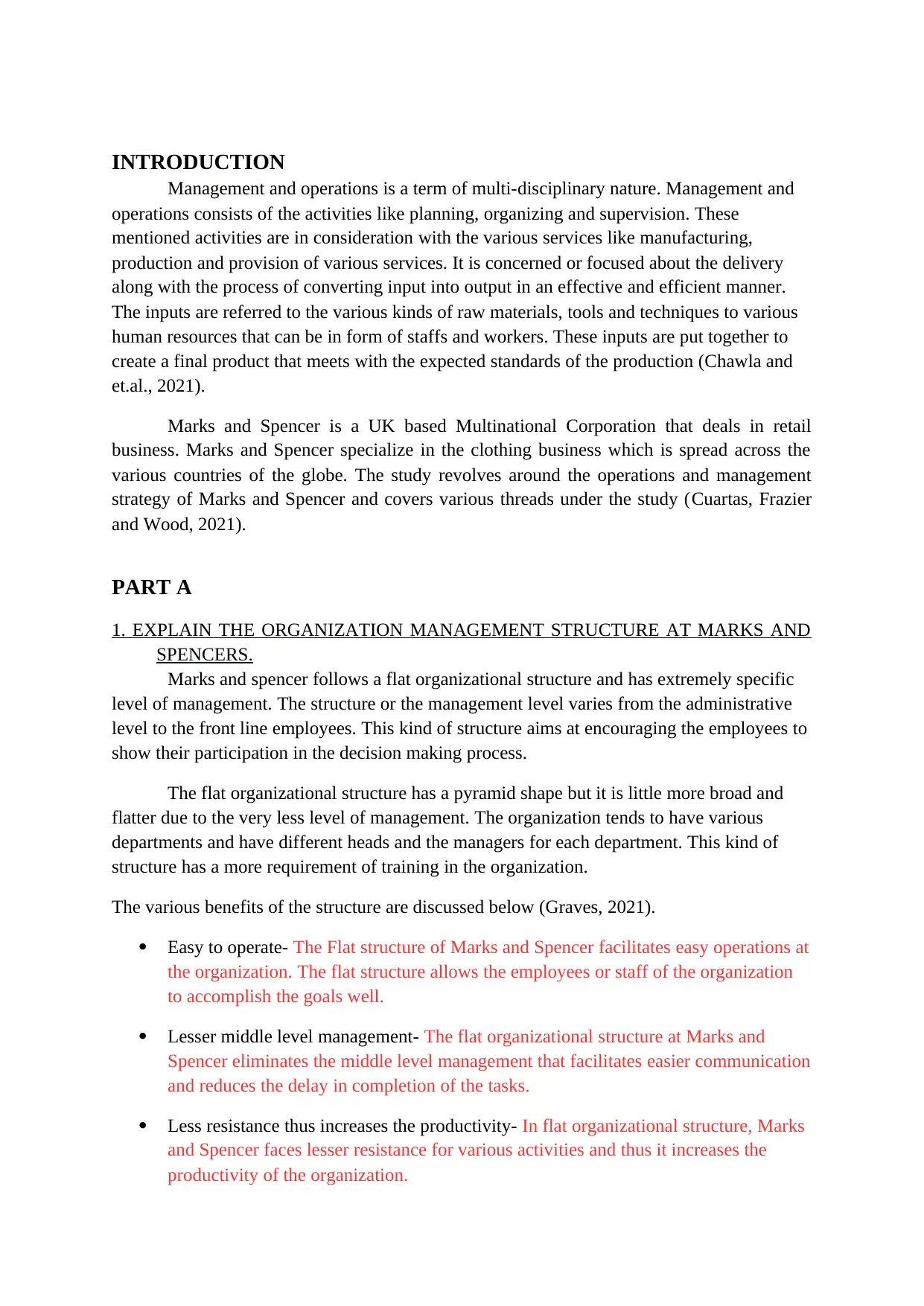
INTRODUCTION
Management and operations is a term of multi-disciplinary nature. Management and
operations consists of the activities like planning, organizing and supervision. These
mentioned activities are in consideration with the various services like manufacturing,
production and provision of various services. It is concerned or focused about the delivery
along with the process of converting input into output in an effective and efficient manner.
The inputs are referred to the various kinds of raw materials, tools and techniques to various
human resources that can be in form of staffs and workers. These inputs are put together to
create a final product that meets with the expected standards of the production (Chawla and
et.al., 2021).
Marks and Spencer is a UK based Multinational Corporation that deals in retail
business. Marks and Spencer specialize in the clothing business which is spread across the
various countries of the globe. The study revolves around the operations and management
strategy of Marks and Spencer and covers various threads under the study (Cuartas, Frazier
and Wood, 2021).
PART A
1. EXPLAIN THE ORGANIZATION MANAGEMENT STRUCTURE AT MARKS AND
SPENCERS.
Marks and spencer follows a flat organizational structure and has extremely specific
level of management. The structure or the management level varies from the administrative
level to the front line employees. This kind of structure aims at encouraging the employees to
show their participation in the decision making process.
The flat organizational structure has a pyramid shape but it is little more broad and
flatter due to the very less level of management. The organization tends to have various
departments and have different heads and the managers for each department. This kind of
structure has a more requirement of training in the organization.
The various benefits of the structure are discussed below (Graves, 2021).
Easy to operate- The Flat structure of Marks and Spencer facilitates easy operations at
the organization. The flat structure allows the employees or staff of the organization
to accomplish the goals well.
Lesser middle level management- The flat organizational structure at Marks and
Spencer eliminates the middle level management that facilitates easier communication
and reduces the delay in completion of the tasks.
Less resistance thus increases the productivity- In flat organizational structure, Marks
and Spencer faces lesser resistance for various activities and thus it increases the
productivity of the organization.
Management and operations is a term of multi-disciplinary nature. Management and
operations consists of the activities like planning, organizing and supervision. These
mentioned activities are in consideration with the various services like manufacturing,
production and provision of various services. It is concerned or focused about the delivery
along with the process of converting input into output in an effective and efficient manner.
The inputs are referred to the various kinds of raw materials, tools and techniques to various
human resources that can be in form of staffs and workers. These inputs are put together to
create a final product that meets with the expected standards of the production (Chawla and
et.al., 2021).
Marks and Spencer is a UK based Multinational Corporation that deals in retail
business. Marks and Spencer specialize in the clothing business which is spread across the
various countries of the globe. The study revolves around the operations and management
strategy of Marks and Spencer and covers various threads under the study (Cuartas, Frazier
and Wood, 2021).
PART A
1. EXPLAIN THE ORGANIZATION MANAGEMENT STRUCTURE AT MARKS AND
SPENCERS.
Marks and spencer follows a flat organizational structure and has extremely specific
level of management. The structure or the management level varies from the administrative
level to the front line employees. This kind of structure aims at encouraging the employees to
show their participation in the decision making process.
The flat organizational structure has a pyramid shape but it is little more broad and
flatter due to the very less level of management. The organization tends to have various
departments and have different heads and the managers for each department. This kind of
structure has a more requirement of training in the organization.
The various benefits of the structure are discussed below (Graves, 2021).
Easy to operate- The Flat structure of Marks and Spencer facilitates easy operations at
the organization. The flat structure allows the employees or staff of the organization
to accomplish the goals well.
Lesser middle level management- The flat organizational structure at Marks and
Spencer eliminates the middle level management that facilitates easier communication
and reduces the delay in completion of the tasks.
Less resistance thus increases the productivity- In flat organizational structure, Marks
and Spencer faces lesser resistance for various activities and thus it increases the
productivity of the organization.
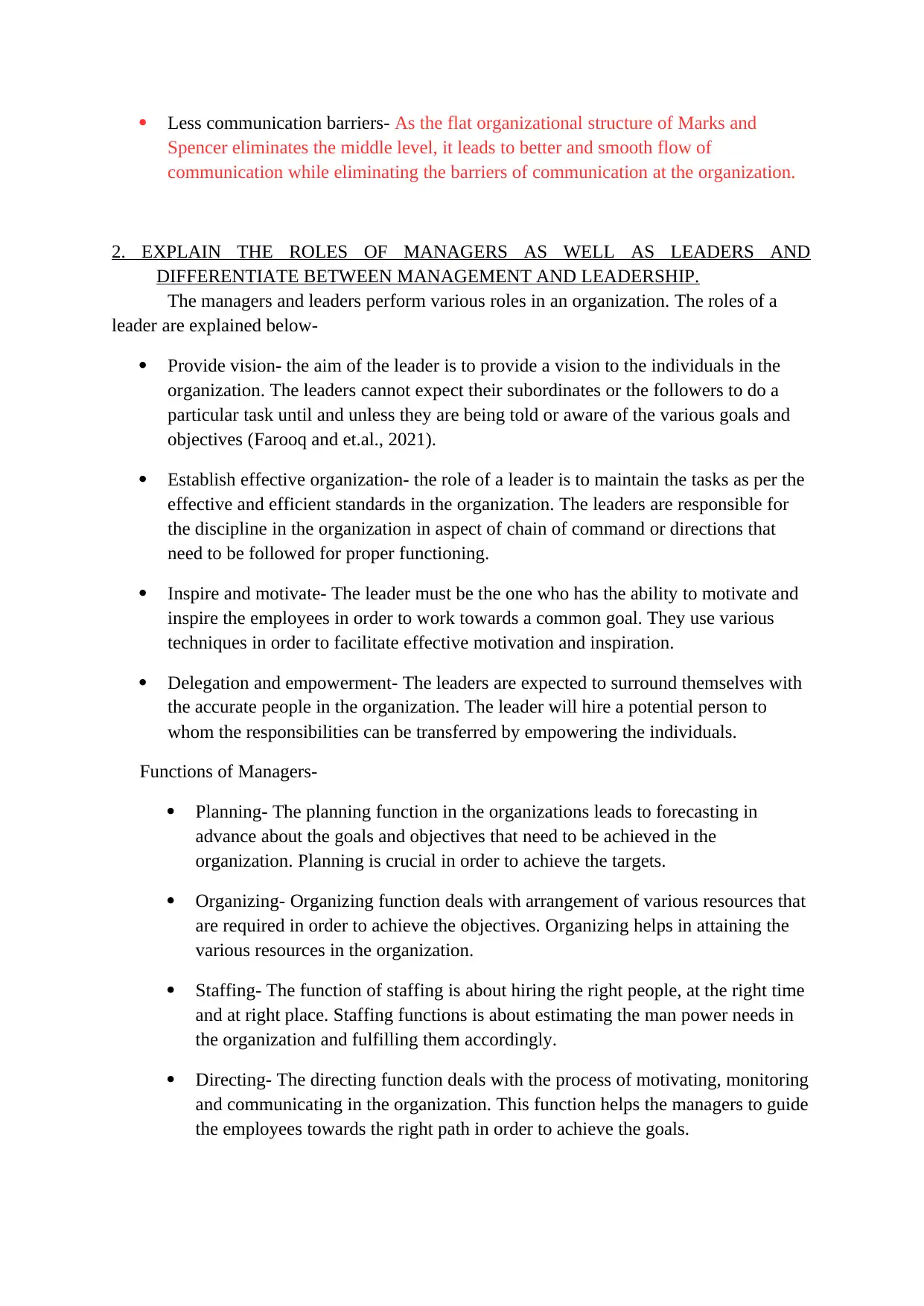
Less communication barriers- As the flat organizational structure of Marks and
Spencer eliminates the middle level, it leads to better and smooth flow of
communication while eliminating the barriers of communication at the organization.
2. EXPLAIN THE ROLES OF MANAGERS AS WELL AS LEADERS AND
DIFFERENTIATE BETWEEN MANAGEMENT AND LEADERSHIP.
The managers and leaders perform various roles in an organization. The roles of a
leader are explained below-
Provide vision- the aim of the leader is to provide a vision to the individuals in the
organization. The leaders cannot expect their subordinates or the followers to do a
particular task until and unless they are being told or aware of the various goals and
objectives (Farooq and et.al., 2021).
Establish effective organization- the role of a leader is to maintain the tasks as per the
effective and efficient standards in the organization. The leaders are responsible for
the discipline in the organization in aspect of chain of command or directions that
need to be followed for proper functioning.
Inspire and motivate- The leader must be the one who has the ability to motivate and
inspire the employees in order to work towards a common goal. They use various
techniques in order to facilitate effective motivation and inspiration.
Delegation and empowerment- The leaders are expected to surround themselves with
the accurate people in the organization. The leader will hire a potential person to
whom the responsibilities can be transferred by empowering the individuals.
Functions of Managers-
Planning- The planning function in the organizations leads to forecasting in
advance about the goals and objectives that need to be achieved in the
organization. Planning is crucial in order to achieve the targets.
Organizing- Organizing function deals with arrangement of various resources that
are required in order to achieve the objectives. Organizing helps in attaining the
various resources in the organization.
Staffing- The function of staffing is about hiring the right people, at the right time
and at right place. Staffing functions is about estimating the man power needs in
the organization and fulfilling them accordingly.
Directing- The directing function deals with the process of motivating, monitoring
and communicating in the organization. This function helps the managers to guide
the employees towards the right path in order to achieve the goals.
Spencer eliminates the middle level, it leads to better and smooth flow of
communication while eliminating the barriers of communication at the organization.
2. EXPLAIN THE ROLES OF MANAGERS AS WELL AS LEADERS AND
DIFFERENTIATE BETWEEN MANAGEMENT AND LEADERSHIP.
The managers and leaders perform various roles in an organization. The roles of a
leader are explained below-
Provide vision- the aim of the leader is to provide a vision to the individuals in the
organization. The leaders cannot expect their subordinates or the followers to do a
particular task until and unless they are being told or aware of the various goals and
objectives (Farooq and et.al., 2021).
Establish effective organization- the role of a leader is to maintain the tasks as per the
effective and efficient standards in the organization. The leaders are responsible for
the discipline in the organization in aspect of chain of command or directions that
need to be followed for proper functioning.
Inspire and motivate- The leader must be the one who has the ability to motivate and
inspire the employees in order to work towards a common goal. They use various
techniques in order to facilitate effective motivation and inspiration.
Delegation and empowerment- The leaders are expected to surround themselves with
the accurate people in the organization. The leader will hire a potential person to
whom the responsibilities can be transferred by empowering the individuals.
Functions of Managers-
Planning- The planning function in the organizations leads to forecasting in
advance about the goals and objectives that need to be achieved in the
organization. Planning is crucial in order to achieve the targets.
Organizing- Organizing function deals with arrangement of various resources that
are required in order to achieve the objectives. Organizing helps in attaining the
various resources in the organization.
Staffing- The function of staffing is about hiring the right people, at the right time
and at right place. Staffing functions is about estimating the man power needs in
the organization and fulfilling them accordingly.
Directing- The directing function deals with the process of motivating, monitoring
and communicating in the organization. This function helps the managers to guide
the employees towards the right path in order to achieve the goals.
Secure Best Marks with AI Grader
Need help grading? Try our AI Grader for instant feedback on your assignments.
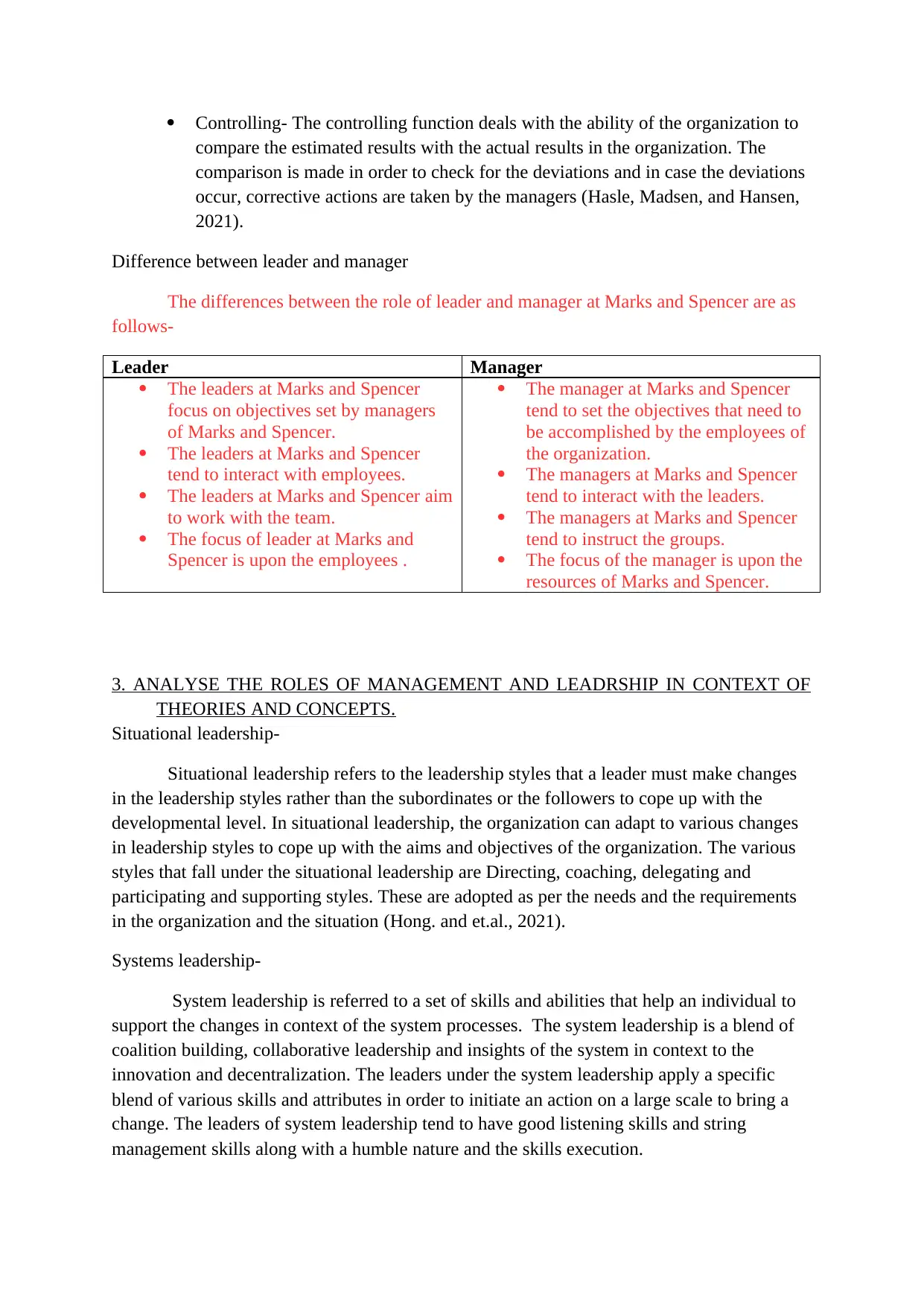
Controlling- The controlling function deals with the ability of the organization to
compare the estimated results with the actual results in the organization. The
comparison is made in order to check for the deviations and in case the deviations
occur, corrective actions are taken by the managers (Hasle, Madsen, and Hansen,
2021).
Difference between leader and manager
The differences between the role of leader and manager at Marks and Spencer are as
follows-
Leader Manager
The leaders at Marks and Spencer
focus on objectives set by managers
of Marks and Spencer.
The leaders at Marks and Spencer
tend to interact with employees.
The leaders at Marks and Spencer aim
to work with the team.
The focus of leader at Marks and
Spencer is upon the employees .
The manager at Marks and Spencer
tend to set the objectives that need to
be accomplished by the employees of
the organization.
The managers at Marks and Spencer
tend to interact with the leaders.
The managers at Marks and Spencer
tend to instruct the groups.
The focus of the manager is upon the
resources of Marks and Spencer.
3. ANALYSE THE ROLES OF MANAGEMENT AND LEADRSHIP IN CONTEXT OF
THEORIES AND CONCEPTS.
Situational leadership-
Situational leadership refers to the leadership styles that a leader must make changes
in the leadership styles rather than the subordinates or the followers to cope up with the
developmental level. In situational leadership, the organization can adapt to various changes
in leadership styles to cope up with the aims and objectives of the organization. The various
styles that fall under the situational leadership are Directing, coaching, delegating and
participating and supporting styles. These are adopted as per the needs and the requirements
in the organization and the situation (Hong. and et.al., 2021).
Systems leadership-
System leadership is referred to a set of skills and abilities that help an individual to
support the changes in context of the system processes. The system leadership is a blend of
coalition building, collaborative leadership and insights of the system in context to the
innovation and decentralization. The leaders under the system leadership apply a specific
blend of various skills and attributes in order to initiate an action on a large scale to bring a
change. The leaders of system leadership tend to have good listening skills and string
management skills along with a humble nature and the skills execution.
compare the estimated results with the actual results in the organization. The
comparison is made in order to check for the deviations and in case the deviations
occur, corrective actions are taken by the managers (Hasle, Madsen, and Hansen,
2021).
Difference between leader and manager
The differences between the role of leader and manager at Marks and Spencer are as
follows-
Leader Manager
The leaders at Marks and Spencer
focus on objectives set by managers
of Marks and Spencer.
The leaders at Marks and Spencer
tend to interact with employees.
The leaders at Marks and Spencer aim
to work with the team.
The focus of leader at Marks and
Spencer is upon the employees .
The manager at Marks and Spencer
tend to set the objectives that need to
be accomplished by the employees of
the organization.
The managers at Marks and Spencer
tend to interact with the leaders.
The managers at Marks and Spencer
tend to instruct the groups.
The focus of the manager is upon the
resources of Marks and Spencer.
3. ANALYSE THE ROLES OF MANAGEMENT AND LEADRSHIP IN CONTEXT OF
THEORIES AND CONCEPTS.
Situational leadership-
Situational leadership refers to the leadership styles that a leader must make changes
in the leadership styles rather than the subordinates or the followers to cope up with the
developmental level. In situational leadership, the organization can adapt to various changes
in leadership styles to cope up with the aims and objectives of the organization. The various
styles that fall under the situational leadership are Directing, coaching, delegating and
participating and supporting styles. These are adopted as per the needs and the requirements
in the organization and the situation (Hong. and et.al., 2021).
Systems leadership-
System leadership is referred to a set of skills and abilities that help an individual to
support the changes in context of the system processes. The system leadership is a blend of
coalition building, collaborative leadership and insights of the system in context to the
innovation and decentralization. The leaders under the system leadership apply a specific
blend of various skills and attributes in order to initiate an action on a large scale to bring a
change. The leaders of system leadership tend to have good listening skills and string
management skills along with a humble nature and the skills execution.
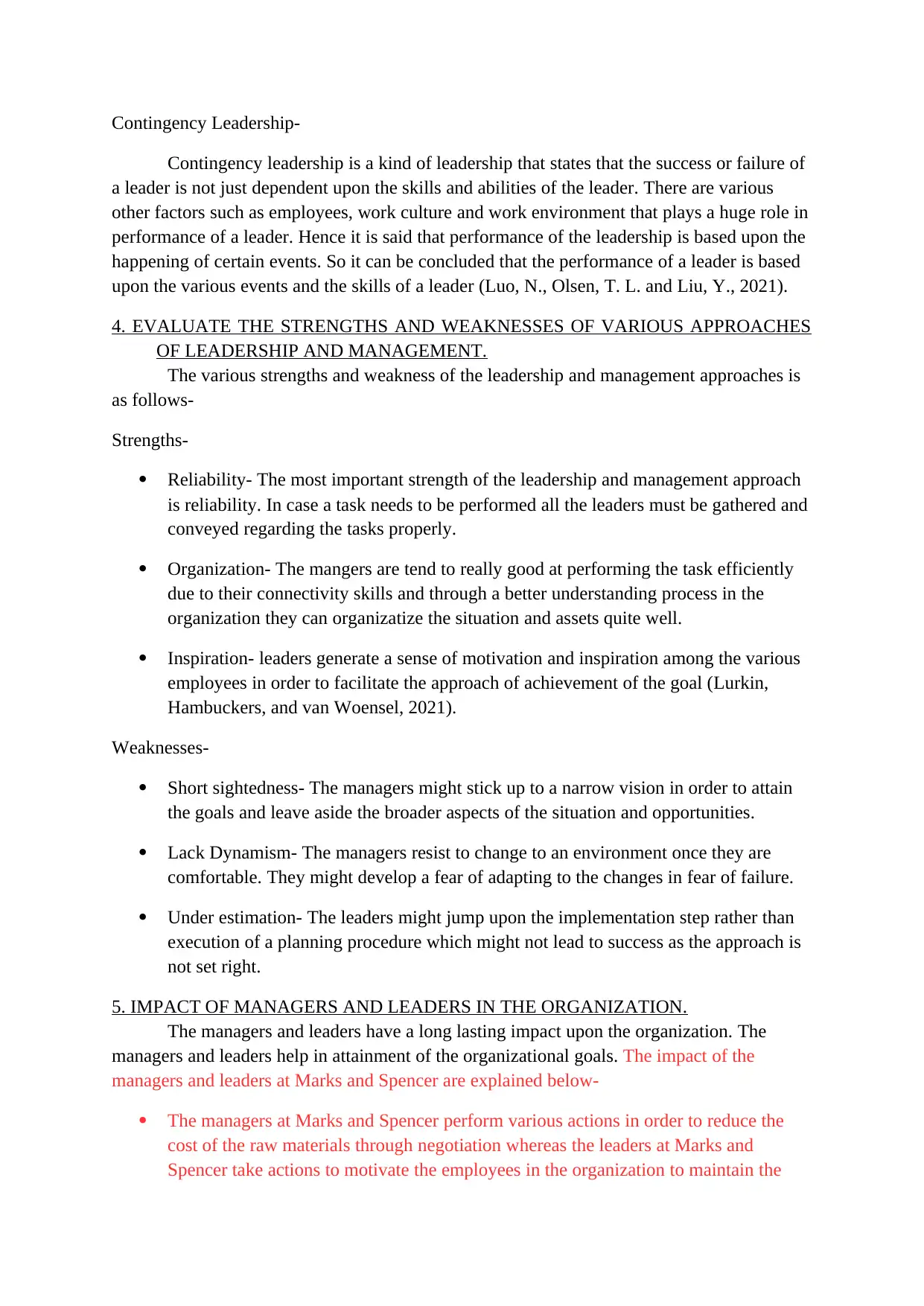
Contingency Leadership-
Contingency leadership is a kind of leadership that states that the success or failure of
a leader is not just dependent upon the skills and abilities of the leader. There are various
other factors such as employees, work culture and work environment that plays a huge role in
performance of a leader. Hence it is said that performance of the leadership is based upon the
happening of certain events. So it can be concluded that the performance of a leader is based
upon the various events and the skills of a leader (Luo, N., Olsen, T. L. and Liu, Y., 2021).
4. EVALUATE THE STRENGTHS AND WEAKNESSES OF VARIOUS APPROACHES
OF LEADERSHIP AND MANAGEMENT.
The various strengths and weakness of the leadership and management approaches is
as follows-
Strengths-
Reliability- The most important strength of the leadership and management approach
is reliability. In case a task needs to be performed all the leaders must be gathered and
conveyed regarding the tasks properly.
Organization- The mangers are tend to really good at performing the task efficiently
due to their connectivity skills and through a better understanding process in the
organization they can organizatize the situation and assets quite well.
Inspiration- leaders generate a sense of motivation and inspiration among the various
employees in order to facilitate the approach of achievement of the goal (Lurkin,
Hambuckers, and van Woensel, 2021).
Weaknesses-
Short sightedness- The managers might stick up to a narrow vision in order to attain
the goals and leave aside the broader aspects of the situation and opportunities.
Lack Dynamism- The managers resist to change to an environment once they are
comfortable. They might develop a fear of adapting to the changes in fear of failure.
Under estimation- The leaders might jump upon the implementation step rather than
execution of a planning procedure which might not lead to success as the approach is
not set right.
5. IMPACT OF MANAGERS AND LEADERS IN THE ORGANIZATION.
The managers and leaders have a long lasting impact upon the organization. The
managers and leaders help in attainment of the organizational goals. The impact of the
managers and leaders at Marks and Spencer are explained below-
The managers at Marks and Spencer perform various actions in order to reduce the
cost of the raw materials through negotiation whereas the leaders at Marks and
Spencer take actions to motivate the employees in the organization to maintain the
Contingency leadership is a kind of leadership that states that the success or failure of
a leader is not just dependent upon the skills and abilities of the leader. There are various
other factors such as employees, work culture and work environment that plays a huge role in
performance of a leader. Hence it is said that performance of the leadership is based upon the
happening of certain events. So it can be concluded that the performance of a leader is based
upon the various events and the skills of a leader (Luo, N., Olsen, T. L. and Liu, Y., 2021).
4. EVALUATE THE STRENGTHS AND WEAKNESSES OF VARIOUS APPROACHES
OF LEADERSHIP AND MANAGEMENT.
The various strengths and weakness of the leadership and management approaches is
as follows-
Strengths-
Reliability- The most important strength of the leadership and management approach
is reliability. In case a task needs to be performed all the leaders must be gathered and
conveyed regarding the tasks properly.
Organization- The mangers are tend to really good at performing the task efficiently
due to their connectivity skills and through a better understanding process in the
organization they can organizatize the situation and assets quite well.
Inspiration- leaders generate a sense of motivation and inspiration among the various
employees in order to facilitate the approach of achievement of the goal (Lurkin,
Hambuckers, and van Woensel, 2021).
Weaknesses-
Short sightedness- The managers might stick up to a narrow vision in order to attain
the goals and leave aside the broader aspects of the situation and opportunities.
Lack Dynamism- The managers resist to change to an environment once they are
comfortable. They might develop a fear of adapting to the changes in fear of failure.
Under estimation- The leaders might jump upon the implementation step rather than
execution of a planning procedure which might not lead to success as the approach is
not set right.
5. IMPACT OF MANAGERS AND LEADERS IN THE ORGANIZATION.
The managers and leaders have a long lasting impact upon the organization. The
managers and leaders help in attainment of the organizational goals. The impact of the
managers and leaders at Marks and Spencer are explained below-
The managers at Marks and Spencer perform various actions in order to reduce the
cost of the raw materials through negotiation whereas the leaders at Marks and
Spencer take actions to motivate the employees in the organization to maintain the
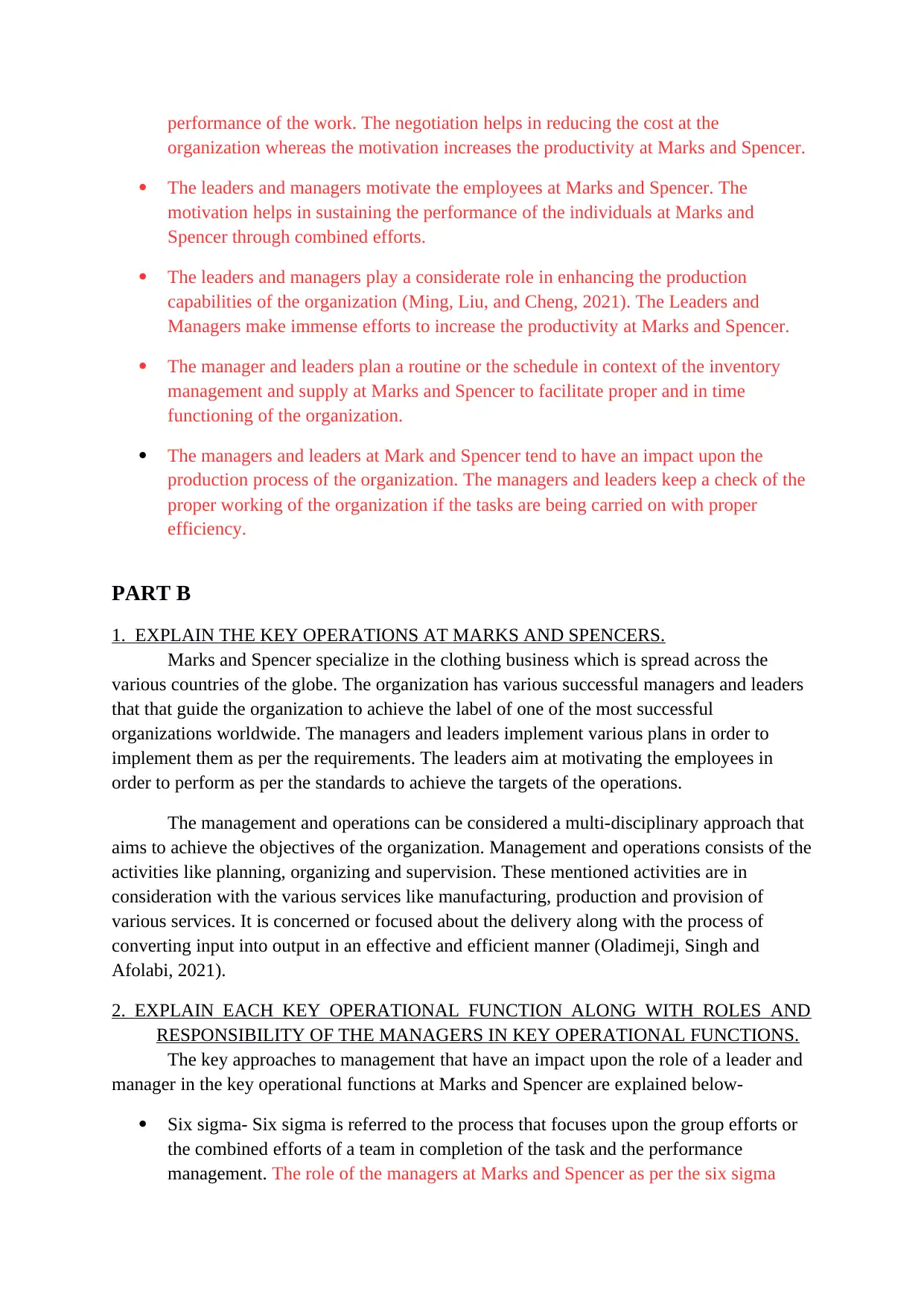
performance of the work. The negotiation helps in reducing the cost at the
organization whereas the motivation increases the productivity at Marks and Spencer.
The leaders and managers motivate the employees at Marks and Spencer. The
motivation helps in sustaining the performance of the individuals at Marks and
Spencer through combined efforts.
The leaders and managers play a considerate role in enhancing the production
capabilities of the organization (Ming, Liu, and Cheng, 2021). The Leaders and
Managers make immense efforts to increase the productivity at Marks and Spencer.
The manager and leaders plan a routine or the schedule in context of the inventory
management and supply at Marks and Spencer to facilitate proper and in time
functioning of the organization.
The managers and leaders at Mark and Spencer tend to have an impact upon the
production process of the organization. The managers and leaders keep a check of the
proper working of the organization if the tasks are being carried on with proper
efficiency.
PART B
1. EXPLAIN THE KEY OPERATIONS AT MARKS AND SPENCERS.
Marks and Spencer specialize in the clothing business which is spread across the
various countries of the globe. The organization has various successful managers and leaders
that that guide the organization to achieve the label of one of the most successful
organizations worldwide. The managers and leaders implement various plans in order to
implement them as per the requirements. The leaders aim at motivating the employees in
order to perform as per the standards to achieve the targets of the operations.
The management and operations can be considered a multi-disciplinary approach that
aims to achieve the objectives of the organization. Management and operations consists of the
activities like planning, organizing and supervision. These mentioned activities are in
consideration with the various services like manufacturing, production and provision of
various services. It is concerned or focused about the delivery along with the process of
converting input into output in an effective and efficient manner (Oladimeji, Singh and
Afolabi, 2021).
2. EXPLAIN EACH KEY OPERATIONAL FUNCTION ALONG WITH ROLES AND
RESPONSIBILITY OF THE MANAGERS IN KEY OPERATIONAL FUNCTIONS.
The key approaches to management that have an impact upon the role of a leader and
manager in the key operational functions at Marks and Spencer are explained below-
Six sigma- Six sigma is referred to the process that focuses upon the group efforts or
the combined efforts of a team in completion of the task and the performance
management. The role of the managers at Marks and Spencer as per the six sigma
organization whereas the motivation increases the productivity at Marks and Spencer.
The leaders and managers motivate the employees at Marks and Spencer. The
motivation helps in sustaining the performance of the individuals at Marks and
Spencer through combined efforts.
The leaders and managers play a considerate role in enhancing the production
capabilities of the organization (Ming, Liu, and Cheng, 2021). The Leaders and
Managers make immense efforts to increase the productivity at Marks and Spencer.
The manager and leaders plan a routine or the schedule in context of the inventory
management and supply at Marks and Spencer to facilitate proper and in time
functioning of the organization.
The managers and leaders at Mark and Spencer tend to have an impact upon the
production process of the organization. The managers and leaders keep a check of the
proper working of the organization if the tasks are being carried on with proper
efficiency.
PART B
1. EXPLAIN THE KEY OPERATIONS AT MARKS AND SPENCERS.
Marks and Spencer specialize in the clothing business which is spread across the
various countries of the globe. The organization has various successful managers and leaders
that that guide the organization to achieve the label of one of the most successful
organizations worldwide. The managers and leaders implement various plans in order to
implement them as per the requirements. The leaders aim at motivating the employees in
order to perform as per the standards to achieve the targets of the operations.
The management and operations can be considered a multi-disciplinary approach that
aims to achieve the objectives of the organization. Management and operations consists of the
activities like planning, organizing and supervision. These mentioned activities are in
consideration with the various services like manufacturing, production and provision of
various services. It is concerned or focused about the delivery along with the process of
converting input into output in an effective and efficient manner (Oladimeji, Singh and
Afolabi, 2021).
2. EXPLAIN EACH KEY OPERATIONAL FUNCTION ALONG WITH ROLES AND
RESPONSIBILITY OF THE MANAGERS IN KEY OPERATIONAL FUNCTIONS.
The key approaches to management that have an impact upon the role of a leader and
manager in the key operational functions at Marks and Spencer are explained below-
Six sigma- Six sigma is referred to the process that focuses upon the group efforts or
the combined efforts of a team in completion of the task and the performance
management. The role of the managers at Marks and Spencer as per the six sigma
Paraphrase This Document
Need a fresh take? Get an instant paraphrase of this document with our AI Paraphraser
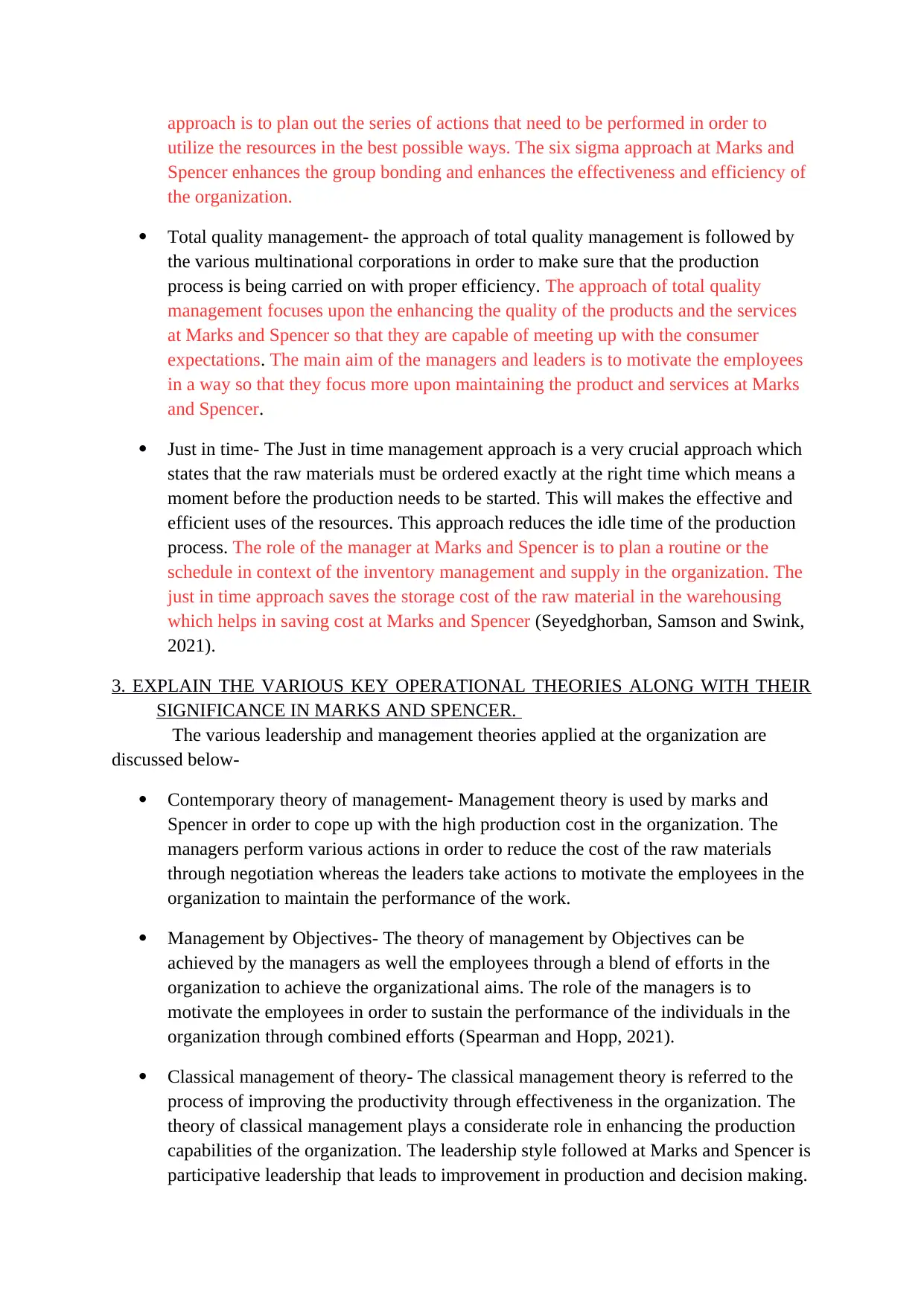
approach is to plan out the series of actions that need to be performed in order to
utilize the resources in the best possible ways. The six sigma approach at Marks and
Spencer enhances the group bonding and enhances the effectiveness and efficiency of
the organization.
Total quality management- the approach of total quality management is followed by
the various multinational corporations in order to make sure that the production
process is being carried on with proper efficiency. The approach of total quality
management focuses upon the enhancing the quality of the products and the services
at Marks and Spencer so that they are capable of meeting up with the consumer
expectations. The main aim of the managers and leaders is to motivate the employees
in a way so that they focus more upon maintaining the product and services at Marks
and Spencer.
Just in time- The Just in time management approach is a very crucial approach which
states that the raw materials must be ordered exactly at the right time which means a
moment before the production needs to be started. This will makes the effective and
efficient uses of the resources. This approach reduces the idle time of the production
process. The role of the manager at Marks and Spencer is to plan a routine or the
schedule in context of the inventory management and supply in the organization. The
just in time approach saves the storage cost of the raw material in the warehousing
which helps in saving cost at Marks and Spencer (Seyedghorban, Samson and Swink,
2021).
3. EXPLAIN THE VARIOUS KEY OPERATIONAL THEORIES ALONG WITH THEIR
SIGNIFICANCE IN MARKS AND SPENCER.
The various leadership and management theories applied at the organization are
discussed below-
Contemporary theory of management- Management theory is used by marks and
Spencer in order to cope up with the high production cost in the organization. The
managers perform various actions in order to reduce the cost of the raw materials
through negotiation whereas the leaders take actions to motivate the employees in the
organization to maintain the performance of the work.
Management by Objectives- The theory of management by Objectives can be
achieved by the managers as well the employees through a blend of efforts in the
organization to achieve the organizational aims. The role of the managers is to
motivate the employees in order to sustain the performance of the individuals in the
organization through combined efforts (Spearman and Hopp, 2021).
Classical management of theory- The classical management theory is referred to the
process of improving the productivity through effectiveness in the organization. The
theory of classical management plays a considerate role in enhancing the production
capabilities of the organization. The leadership style followed at Marks and Spencer is
participative leadership that leads to improvement in production and decision making.
utilize the resources in the best possible ways. The six sigma approach at Marks and
Spencer enhances the group bonding and enhances the effectiveness and efficiency of
the organization.
Total quality management- the approach of total quality management is followed by
the various multinational corporations in order to make sure that the production
process is being carried on with proper efficiency. The approach of total quality
management focuses upon the enhancing the quality of the products and the services
at Marks and Spencer so that they are capable of meeting up with the consumer
expectations. The main aim of the managers and leaders is to motivate the employees
in a way so that they focus more upon maintaining the product and services at Marks
and Spencer.
Just in time- The Just in time management approach is a very crucial approach which
states that the raw materials must be ordered exactly at the right time which means a
moment before the production needs to be started. This will makes the effective and
efficient uses of the resources. This approach reduces the idle time of the production
process. The role of the manager at Marks and Spencer is to plan a routine or the
schedule in context of the inventory management and supply in the organization. The
just in time approach saves the storage cost of the raw material in the warehousing
which helps in saving cost at Marks and Spencer (Seyedghorban, Samson and Swink,
2021).
3. EXPLAIN THE VARIOUS KEY OPERATIONAL THEORIES ALONG WITH THEIR
SIGNIFICANCE IN MARKS AND SPENCER.
The various leadership and management theories applied at the organization are
discussed below-
Contemporary theory of management- Management theory is used by marks and
Spencer in order to cope up with the high production cost in the organization. The
managers perform various actions in order to reduce the cost of the raw materials
through negotiation whereas the leaders take actions to motivate the employees in the
organization to maintain the performance of the work.
Management by Objectives- The theory of management by Objectives can be
achieved by the managers as well the employees through a blend of efforts in the
organization to achieve the organizational aims. The role of the managers is to
motivate the employees in order to sustain the performance of the individuals in the
organization through combined efforts (Spearman and Hopp, 2021).
Classical management of theory- The classical management theory is referred to the
process of improving the productivity through effectiveness in the organization. The
theory of classical management plays a considerate role in enhancing the production
capabilities of the organization. The leadership style followed at Marks and Spencer is
participative leadership that leads to improvement in production and decision making.
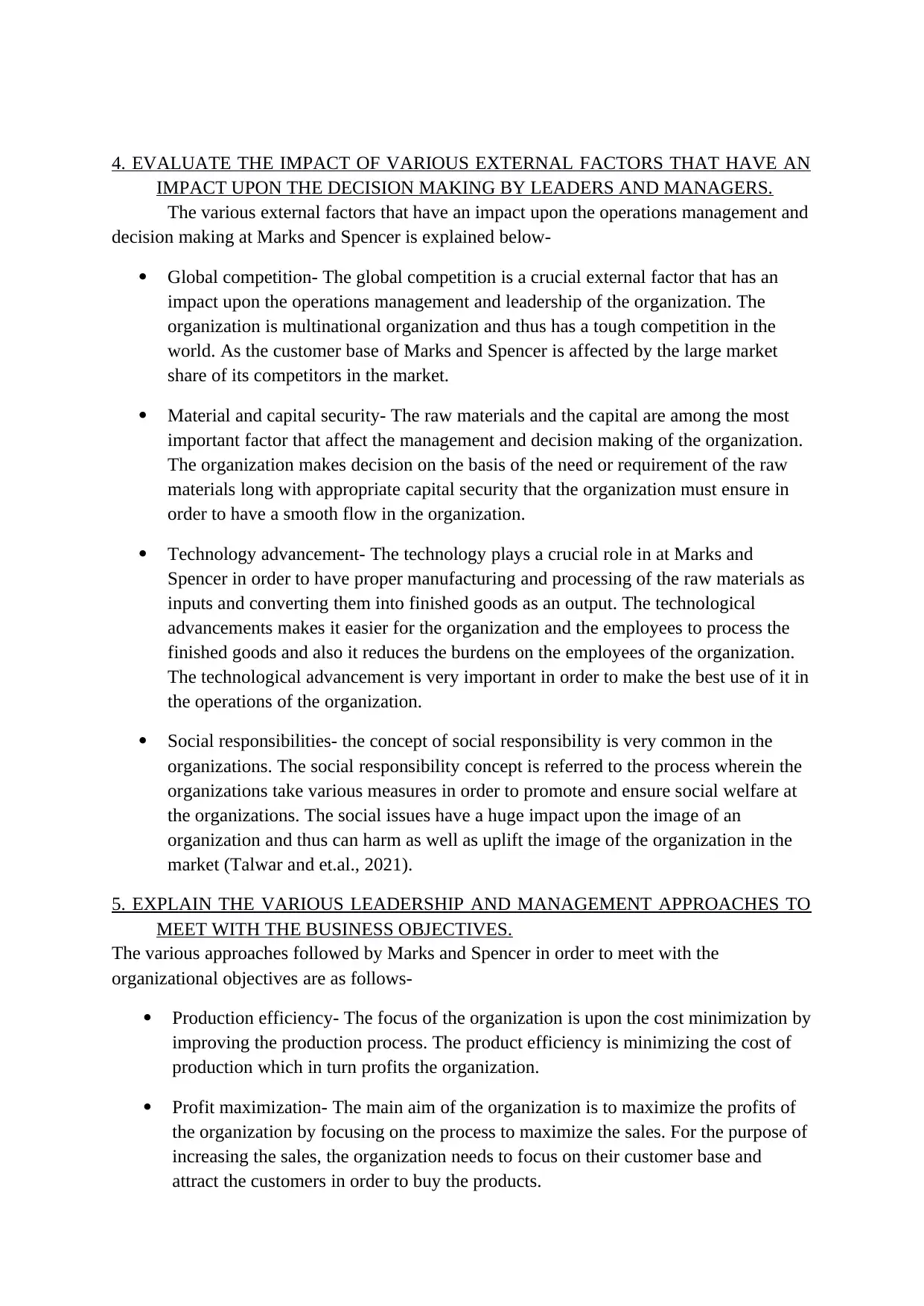
4. EVALUATE THE IMPACT OF VARIOUS EXTERNAL FACTORS THAT HAVE AN
IMPACT UPON THE DECISION MAKING BY LEADERS AND MANAGERS.
The various external factors that have an impact upon the operations management and
decision making at Marks and Spencer is explained below-
Global competition- The global competition is a crucial external factor that has an
impact upon the operations management and leadership of the organization. The
organization is multinational organization and thus has a tough competition in the
world. As the customer base of Marks and Spencer is affected by the large market
share of its competitors in the market.
Material and capital security- The raw materials and the capital are among the most
important factor that affect the management and decision making of the organization.
The organization makes decision on the basis of the need or requirement of the raw
materials long with appropriate capital security that the organization must ensure in
order to have a smooth flow in the organization.
Technology advancement- The technology plays a crucial role in at Marks and
Spencer in order to have proper manufacturing and processing of the raw materials as
inputs and converting them into finished goods as an output. The technological
advancements makes it easier for the organization and the employees to process the
finished goods and also it reduces the burdens on the employees of the organization.
The technological advancement is very important in order to make the best use of it in
the operations of the organization.
Social responsibilities- the concept of social responsibility is very common in the
organizations. The social responsibility concept is referred to the process wherein the
organizations take various measures in order to promote and ensure social welfare at
the organizations. The social issues have a huge impact upon the image of an
organization and thus can harm as well as uplift the image of the organization in the
market (Talwar and et.al., 2021).
5. EXPLAIN THE VARIOUS LEADERSHIP AND MANAGEMENT APPROACHES TO
MEET WITH THE BUSINESS OBJECTIVES.
The various approaches followed by Marks and Spencer in order to meet with the
organizational objectives are as follows-
Production efficiency- The focus of the organization is upon the cost minimization by
improving the production process. The product efficiency is minimizing the cost of
production which in turn profits the organization.
Profit maximization- The main aim of the organization is to maximize the profits of
the organization by focusing on the process to maximize the sales. For the purpose of
increasing the sales, the organization needs to focus on their customer base and
attract the customers in order to buy the products.
IMPACT UPON THE DECISION MAKING BY LEADERS AND MANAGERS.
The various external factors that have an impact upon the operations management and
decision making at Marks and Spencer is explained below-
Global competition- The global competition is a crucial external factor that has an
impact upon the operations management and leadership of the organization. The
organization is multinational organization and thus has a tough competition in the
world. As the customer base of Marks and Spencer is affected by the large market
share of its competitors in the market.
Material and capital security- The raw materials and the capital are among the most
important factor that affect the management and decision making of the organization.
The organization makes decision on the basis of the need or requirement of the raw
materials long with appropriate capital security that the organization must ensure in
order to have a smooth flow in the organization.
Technology advancement- The technology plays a crucial role in at Marks and
Spencer in order to have proper manufacturing and processing of the raw materials as
inputs and converting them into finished goods as an output. The technological
advancements makes it easier for the organization and the employees to process the
finished goods and also it reduces the burdens on the employees of the organization.
The technological advancement is very important in order to make the best use of it in
the operations of the organization.
Social responsibilities- the concept of social responsibility is very common in the
organizations. The social responsibility concept is referred to the process wherein the
organizations take various measures in order to promote and ensure social welfare at
the organizations. The social issues have a huge impact upon the image of an
organization and thus can harm as well as uplift the image of the organization in the
market (Talwar and et.al., 2021).
5. EXPLAIN THE VARIOUS LEADERSHIP AND MANAGEMENT APPROACHES TO
MEET WITH THE BUSINESS OBJECTIVES.
The various approaches followed by Marks and Spencer in order to meet with the
organizational objectives are as follows-
Production efficiency- The focus of the organization is upon the cost minimization by
improving the production process. The product efficiency is minimizing the cost of
production which in turn profits the organization.
Profit maximization- The main aim of the organization is to maximize the profits of
the organization by focusing on the process to maximize the sales. For the purpose of
increasing the sales, the organization needs to focus on their customer base and
attract the customers in order to buy the products.
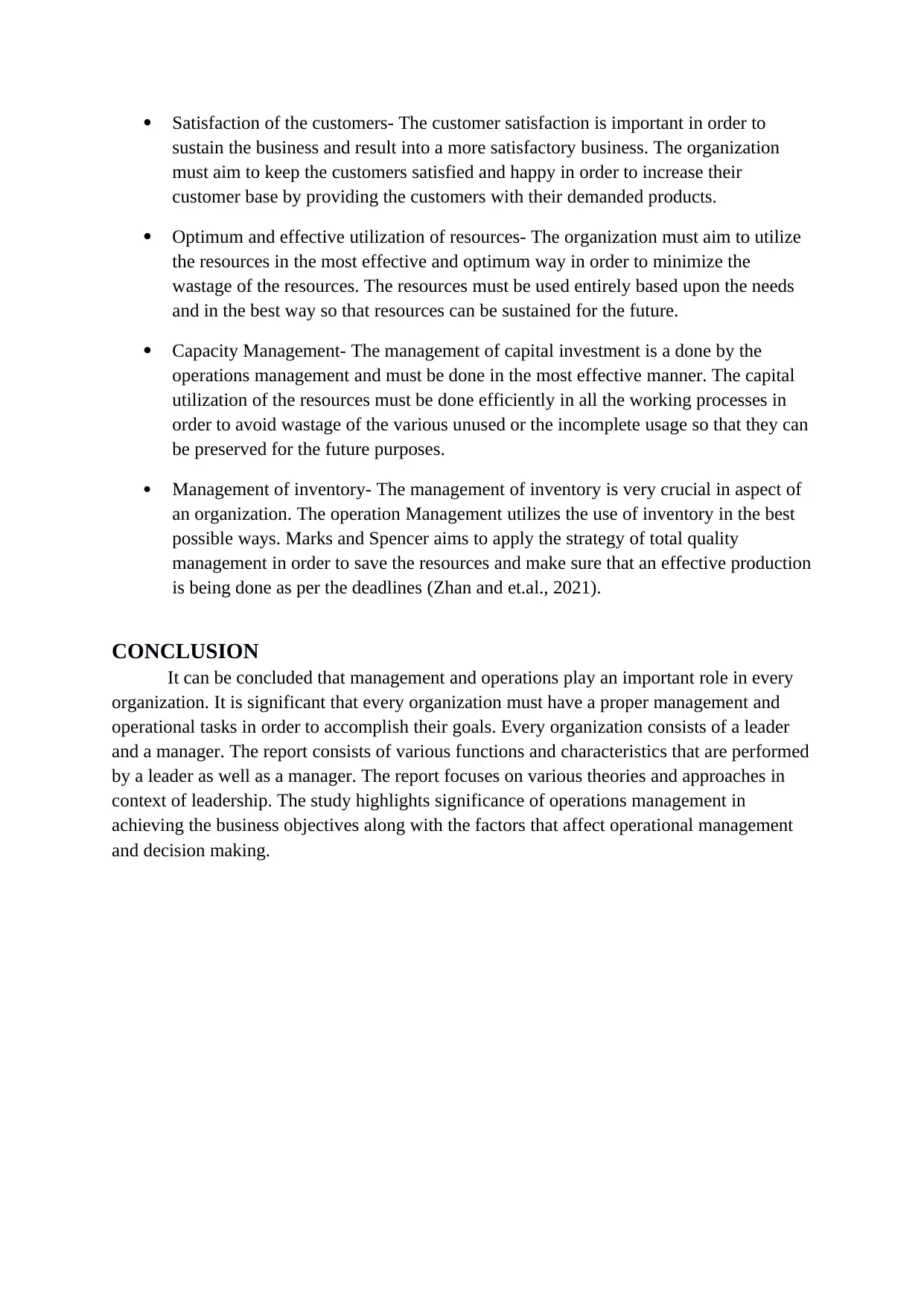
Satisfaction of the customers- The customer satisfaction is important in order to
sustain the business and result into a more satisfactory business. The organization
must aim to keep the customers satisfied and happy in order to increase their
customer base by providing the customers with their demanded products.
Optimum and effective utilization of resources- The organization must aim to utilize
the resources in the most effective and optimum way in order to minimize the
wastage of the resources. The resources must be used entirely based upon the needs
and in the best way so that resources can be sustained for the future.
Capacity Management- The management of capital investment is a done by the
operations management and must be done in the most effective manner. The capital
utilization of the resources must be done efficiently in all the working processes in
order to avoid wastage of the various unused or the incomplete usage so that they can
be preserved for the future purposes.
Management of inventory- The management of inventory is very crucial in aspect of
an organization. The operation Management utilizes the use of inventory in the best
possible ways. Marks and Spencer aims to apply the strategy of total quality
management in order to save the resources and make sure that an effective production
is being done as per the deadlines (Zhan and et.al., 2021).
CONCLUSION
It can be concluded that management and operations play an important role in every
organization. It is significant that every organization must have a proper management and
operational tasks in order to accomplish their goals. Every organization consists of a leader
and a manager. The report consists of various functions and characteristics that are performed
by a leader as well as a manager. The report focuses on various theories and approaches in
context of leadership. The study highlights significance of operations management in
achieving the business objectives along with the factors that affect operational management
and decision making.
sustain the business and result into a more satisfactory business. The organization
must aim to keep the customers satisfied and happy in order to increase their
customer base by providing the customers with their demanded products.
Optimum and effective utilization of resources- The organization must aim to utilize
the resources in the most effective and optimum way in order to minimize the
wastage of the resources. The resources must be used entirely based upon the needs
and in the best way so that resources can be sustained for the future.
Capacity Management- The management of capital investment is a done by the
operations management and must be done in the most effective manner. The capital
utilization of the resources must be done efficiently in all the working processes in
order to avoid wastage of the various unused or the incomplete usage so that they can
be preserved for the future purposes.
Management of inventory- The management of inventory is very crucial in aspect of
an organization. The operation Management utilizes the use of inventory in the best
possible ways. Marks and Spencer aims to apply the strategy of total quality
management in order to save the resources and make sure that an effective production
is being done as per the deadlines (Zhan and et.al., 2021).
CONCLUSION
It can be concluded that management and operations play an important role in every
organization. It is significant that every organization must have a proper management and
operational tasks in order to accomplish their goals. Every organization consists of a leader
and a manager. The report consists of various functions and characteristics that are performed
by a leader as well as a manager. The report focuses on various theories and approaches in
context of leadership. The study highlights significance of operations management in
achieving the business objectives along with the factors that affect operational management
and decision making.
Secure Best Marks with AI Grader
Need help grading? Try our AI Grader for instant feedback on your assignments.
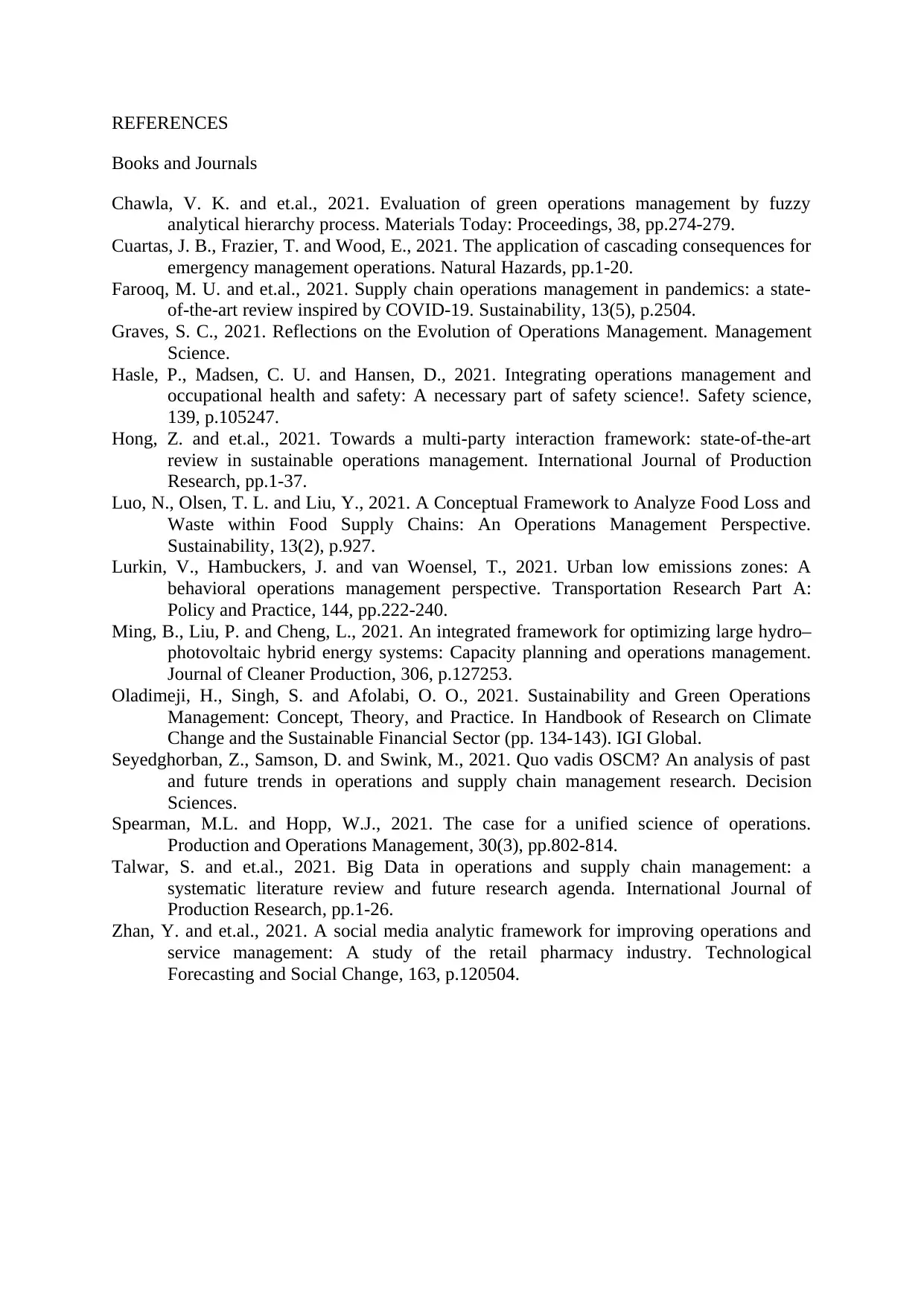
REFERENCES
Books and Journals
Chawla, V. K. and et.al., 2021. Evaluation of green operations management by fuzzy
analytical hierarchy process. Materials Today: Proceedings, 38, pp.274-279.
Cuartas, J. B., Frazier, T. and Wood, E., 2021. The application of cascading consequences for
emergency management operations. Natural Hazards, pp.1-20.
Farooq, M. U. and et.al., 2021. Supply chain operations management in pandemics: a state-
of-the-art review inspired by COVID-19. Sustainability, 13(5), p.2504.
Graves, S. C., 2021. Reflections on the Evolution of Operations Management. Management
Science.
Hasle, P., Madsen, C. U. and Hansen, D., 2021. Integrating operations management and
occupational health and safety: A necessary part of safety science!. Safety science,
139, p.105247.
Hong, Z. and et.al., 2021. Towards a multi-party interaction framework: state-of-the-art
review in sustainable operations management. International Journal of Production
Research, pp.1-37.
Luo, N., Olsen, T. L. and Liu, Y., 2021. A Conceptual Framework to Analyze Food Loss and
Waste within Food Supply Chains: An Operations Management Perspective.
Sustainability, 13(2), p.927.
Lurkin, V., Hambuckers, J. and van Woensel, T., 2021. Urban low emissions zones: A
behavioral operations management perspective. Transportation Research Part A:
Policy and Practice, 144, pp.222-240.
Ming, B., Liu, P. and Cheng, L., 2021. An integrated framework for optimizing large hydro–
photovoltaic hybrid energy systems: Capacity planning and operations management.
Journal of Cleaner Production, 306, p.127253.
Oladimeji, H., Singh, S. and Afolabi, O. O., 2021. Sustainability and Green Operations
Management: Concept, Theory, and Practice. In Handbook of Research on Climate
Change and the Sustainable Financial Sector (pp. 134-143). IGI Global.
Seyedghorban, Z., Samson, D. and Swink, M., 2021. Quo vadis OSCM? An analysis of past
and future trends in operations and supply chain management research. Decision
Sciences.
Spearman, M.L. and Hopp, W.J., 2021. The case for a unified science of operations.
Production and Operations Management, 30(3), pp.802-814.
Talwar, S. and et.al., 2021. Big Data in operations and supply chain management: a
systematic literature review and future research agenda. International Journal of
Production Research, pp.1-26.
Zhan, Y. and et.al., 2021. A social media analytic framework for improving operations and
service management: A study of the retail pharmacy industry. Technological
Forecasting and Social Change, 163, p.120504.
Books and Journals
Chawla, V. K. and et.al., 2021. Evaluation of green operations management by fuzzy
analytical hierarchy process. Materials Today: Proceedings, 38, pp.274-279.
Cuartas, J. B., Frazier, T. and Wood, E., 2021. The application of cascading consequences for
emergency management operations. Natural Hazards, pp.1-20.
Farooq, M. U. and et.al., 2021. Supply chain operations management in pandemics: a state-
of-the-art review inspired by COVID-19. Sustainability, 13(5), p.2504.
Graves, S. C., 2021. Reflections on the Evolution of Operations Management. Management
Science.
Hasle, P., Madsen, C. U. and Hansen, D., 2021. Integrating operations management and
occupational health and safety: A necessary part of safety science!. Safety science,
139, p.105247.
Hong, Z. and et.al., 2021. Towards a multi-party interaction framework: state-of-the-art
review in sustainable operations management. International Journal of Production
Research, pp.1-37.
Luo, N., Olsen, T. L. and Liu, Y., 2021. A Conceptual Framework to Analyze Food Loss and
Waste within Food Supply Chains: An Operations Management Perspective.
Sustainability, 13(2), p.927.
Lurkin, V., Hambuckers, J. and van Woensel, T., 2021. Urban low emissions zones: A
behavioral operations management perspective. Transportation Research Part A:
Policy and Practice, 144, pp.222-240.
Ming, B., Liu, P. and Cheng, L., 2021. An integrated framework for optimizing large hydro–
photovoltaic hybrid energy systems: Capacity planning and operations management.
Journal of Cleaner Production, 306, p.127253.
Oladimeji, H., Singh, S. and Afolabi, O. O., 2021. Sustainability and Green Operations
Management: Concept, Theory, and Practice. In Handbook of Research on Climate
Change and the Sustainable Financial Sector (pp. 134-143). IGI Global.
Seyedghorban, Z., Samson, D. and Swink, M., 2021. Quo vadis OSCM? An analysis of past
and future trends in operations and supply chain management research. Decision
Sciences.
Spearman, M.L. and Hopp, W.J., 2021. The case for a unified science of operations.
Production and Operations Management, 30(3), pp.802-814.
Talwar, S. and et.al., 2021. Big Data in operations and supply chain management: a
systematic literature review and future research agenda. International Journal of
Production Research, pp.1-26.
Zhan, Y. and et.al., 2021. A social media analytic framework for improving operations and
service management: A study of the retail pharmacy industry. Technological
Forecasting and Social Change, 163, p.120504.
1 out of 11
Related Documents
Your All-in-One AI-Powered Toolkit for Academic Success.
+13062052269
info@desklib.com
Available 24*7 on WhatsApp / Email
![[object Object]](/_next/static/media/star-bottom.7253800d.svg)
Unlock your academic potential
© 2024 | Zucol Services PVT LTD | All rights reserved.





